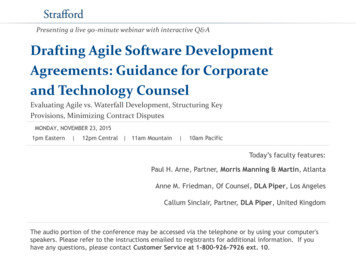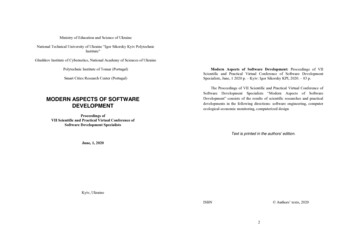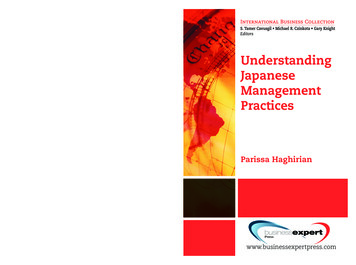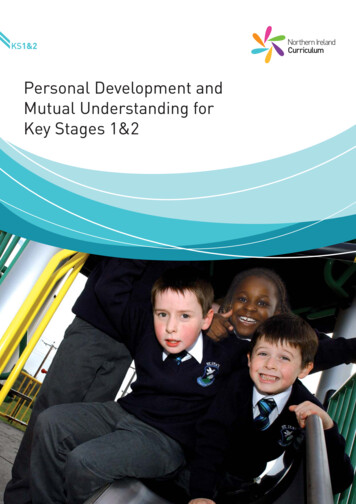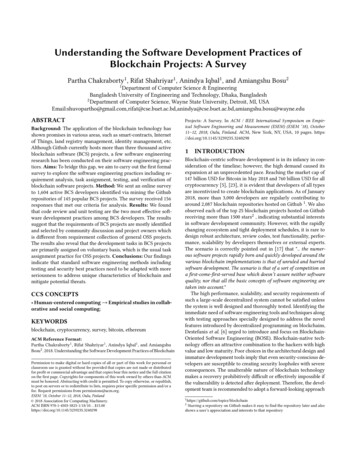
Transcription
Understanding the Software Development Practices ofBlockchain Projects: A SurveyPartha Chakraborty1 , Rifat Shahriyar1 , Anindya Iqbal1 , and Amiangshu Bosu21 Departmentof Computer Science & EngineeringBangladesh University of Engineering and Technology, Dhaka, Bangladesh2 Department of Computer Science, Wayne State University, Detroit, MI, BSTRACTBackground: The application of the blockchain technology hasshown promises in various areas, such as smart-contracts, Internetof Things, land registry management, identity management, etc.Although Github currently hosts more than three thousand activeblockchain software (BCS) projects, a few software engineeringresearch has been conducted on their software engineering practices. Aims: To bridge this gap, we aim to carry out the first formalsurvey to explore the software engineering practices including requirement analysis, task assignment, testing, and verification ofblockchain software projects. Method: We sent an online surveyto 1,604 active BCS developers identified via mining the Githubrepositories of 145 popular BCS projects. The survey received 156responses that met our criteria for analysis. Results: We foundthat code review and unit testing are the two most effective software development practices among BCS developers. The resultssuggest that the requirements of BCS projects are mostly identifiedand selected by community discussion and project owners whichis different from requirement collection of general OSS projects.The results also reveal that the development tasks in BCS projectsare primarily assigned on voluntary basis, which is the usual taskassignment practice for OSS projects. Conclusions: Our findingsindicate that standard software engineering methods includingtesting and security best practices need to be adapted with moreseriousness to address unique characteristics of blockchain andmitigate potential threats.CCS CONCEPTS Human-centered computing Empirical studies in collaborative and social computing;KEYWORDSblockchain, cryptocurrency, survey, bitcoin, ethereumACM Reference Format:Partha Chakraborty1 , Rifat Shahriyar1 , Anindya Iqbal1 , and AmiangshuBosu2 . 2018. Understanding the Software Development Practices of BlockchainPermission to make digital or hard copies of all or part of this work for personal orclassroom use is granted without fee provided that copies are not made or distributedfor profit or commercial advantage and that copies bear this notice and the full citationon the first page. Copyrights for components of this work owned by others than ACMmust be honored. Abstracting with credit is permitted. To copy otherwise, or republish,to post on servers or to redistribute to lists, requires prior specific permission and/or afee. Request permissions from permissions@acm.org.ESEM ’18, October 11–12, 2018, Oulu, Finland 2018 Association for Computing Machinery.ACM ISBN 978-1-4503-5823-1/18/10. . . ts: A Survey. In ACM / IEEE International Symposium on Empirical Software Engineering and Measurement (ESEM) (ESEM ’18), October11–12, 2018, Oulu, Finland. ACM, New York, NY, USA, 10 pages. ONBlockchain-centric software development is in its infancy in consideration of the timeline; however, the high demand caused itsexpansion at an unprecedented pace. Reaching the market cap of147 billion USD for Bitcoin in May 2018 and 760 billion USD for allcryptocurrency [5], [23], it is evident that developers of all typesare incentivized to create blockchain applications. As of January2018, more than 3,000 developers are regularly contributing toaround 2,087 blockchain repositories hosted on Github 1 . We alsoobserved each of the top 25 blockchain projects hosted on Githubreceiving more than 1500 stars2 , indicating substantial interestsin software development community. However, with the rapidlychanging ecosystem and tight deployment schedules, it is rare todesign robust architecture, review codes, test functionality, performance, scalability by developers themselves or external experts.The scenario is correctly pointed out in [17] that ". the numerous software projects rapidly born and quickly developed around thevarious blockchain implementations is that of unruled and hurriedsoftware development. The scenario is that of a sort of competition ona first-come-first-served base which doesn’t assure neither softwarequality, nor that all the basic concepts of software engineering aretaken into account."The high performance, scalability, and security requirements ofsuch a large-scale decentralized system cannot be satisfied unlessthe system is well designed and thoroughly tested. Identifying theimmediate need of software engineering tools and techniques alongwith testing approaches specially designed to address the novelfeatures introduced by decentralized programming on blockchains,Destefanis et al. [6] urged to introduce and focus on BlockchainOriented Software Engineering (BOSE). Blockchain-native technology offers an attractive combination to the hackers with highvalue and low maturity. Poor choices in the architectural design andimmature development tools imply that even security-conscious developers are susceptible to creating security loopholes with severeconsequences. The unalterable nature of blockchain technologymakes a recovery prohibitively difficult or effectively impossible ifthe vulnerability is detected after deployment. Therefore, the development team is recommended to adopt a forward-looking approach1 https://github.com/topics/blockchain2Starring a repository on Github makes it easy to find the repository later and alsoshows a user’s appreciation and interests to that repository
ESEM ’18, October 11–12, 2018, Oulu, Finlandto software engineering best practices, secure development, andextensive testing for eliminating bugs before they enter into thesystem [23]. Destefanis et al. has shown in [6] that the infamousParity attack that caused freezing of 162 Million USD [22] couldbe mitigated with proper adoption of software engineering bestpractices.Other relevant software engineering components that are likelyto have a critical impact on blockchain development are the requirement collection/analysis and task assignment among the projectmembers. Since the market is very competitive, innovative productsare coming to the fore almost every month; requirement specification on of attractive and new features is a significant challenge.The reason behind additional complexity in task assignment forblockchain-native projects (compared to regular software development) stem from the inherent nature of the development teamwhich is mostly sparse geographically and loosely controlled sincemost of the projects are open source.To provide the robustness blockchain applications demand, first,we have to concretely understand the current software engineeringpractices of BCS projects or lack thereof. The exact practices couldbe understood reliably from the developers themselves. To the bestof our knowledge, there is no formal study on the software engineering methods followed by blockchain development projects thatwould reveal the facts about the concern of the research community. To provide the currently missing insight on blockchain-centricprojects, we have set an objective to carry out the first formal surveyto explore the software engineering practices including requirementanalysis, task assignment, testing, and verification. Specifically, weare interested in the developers’ opinion about several questionsregarding blockchain-centric development practices. For example,i) Which are the software development practices that BCS developersfollow? ii) How do BCS developers identify and select the requirementsfor their projects? iii) How are development tasks assigned to the BCSproject members? iv) How is the correctness of BCS projects code verified? v) How are BCS projects tested for security and scalability? andvi) What are the communication channels for the BCS developers?To conduct the study we sent an online survey to 1,604 BCSdevelopers gathered via mining the Github repositories of 145 BCSprojects. The survey is an ideal instrument for this study as currentBCS developers have first-hand experiences of their challenges andneeds. The survey received 156 responses from BCS developers thatmet our criteria for analysis. We adopted a systematic qualitativeanalysis approach to building a coding scheme for the open-endedresponses. Using a qualitative analysis software, multiple codersindependently assigned codes to each response and achieved a‘substantial’ inter-rater reliability [4].Our study finds some similarities of BCS applications with general OSS projects and also some interesting differences. For instance,the requirements of BCS projects are mostly identified and selectedby community discussion and project owners, which is differentfrom requirement collection of general OSS projects where therequirements are mostly selected by developers [15, 19]. On theother hand, the development tasks in BCS projects are primarilyassigned on a voluntary basis, which is similar to the case of OSSprojects [24]. Regarding software engineering practice, code reviewand unit testing are the two most popular ones among BCS developers, and they hardly prefer pair programming which is very popularChakraborty et al.Figure 1: Simplified diagram of a blockchainamong OSS developers. The lack of specialized tools for blockchainto automate integration, regression, and security testing demandsattention from developers of SE tools and relevant researchers.The remainder of the paper is organized as follows. Section 2provides a background on blockchain. Section 3 introduces theresearch questions of this study. Section 4 describes our researchmethodology. Section 5 describes the demographics of the respondents and their projects. Section 6 presents the results of this study.Section 7 discusses the implications of our findings. Section 8 describes the threats to the validity of our results. Finally, Section 9concludes the paper.2BACKGROUNDBlockchain is a decentralized, peer-to-peer, public, immutable, andappend-only data storage. It keeps a permanent record of writescalled transactions. Multiple transactions are grouped in blocks.Each block in a blockchain contains its hash computed using awell-known hashing or proof-of-work [10] algorithm (e.g., SHA256,ethash, and equihash) and the hash of the previous block calledparent block (Figure 1). The first block in a chain is called thegenesis block, which does not have any parent. Each block’shash is calculated based on its data, current timestamp and the hashof its parent block. Any change in a block’s data causes alteration ofits hash and invalidates all the subsequent blocks and the tamperingbecomes immediately evident to every member node of the chain.Hence, to compromise a blockchain, collusion of the majority ofthe network is required which is impractical in case of a largeblockchain [14]. Therefore, blockchain is a chain of blocks wherethe blocks are irreversible and immutable.All the nodes in a blockchain network participate simultaneouslyto find the next block to write. This process is called mining, wherethe nodes calculate a hash value by adding a nonce (i.e., a randomvalue) to a list of transactions waiting to be added to the blockchain.To be eligible as the next block, the hash must be smaller than anagreed-upon value (known as difficulty), and the nodes continuecalculations using different nonces until they find a nonce thatgenerates a hash satisfying the ‘difficulty’. The node finding a newblock will broadcast it to all other nodes in the network to confirmthe correctness of this new block. Once confirmed, the new block isadded to the blockchain and each of the transactions contained inthe block is considered verified [3]. The finder is usually rewardedwith a predefined number of tokens, known as block reward. Thedifficulty of the next block is determined by the network with apredefined algorithm.There is no central control over the operation of a blockchain.The underlying philosophy is that no single participant or group of
Understanding the Software Development Practices of Blockchain Projects: A Surveyparticipants can control the infrastructure and all the participantsin the network have an equal role to play. In the absence of a centralcontroller, the transactions are mediated by the member nodes usinga consensus protocol, which ensures that all the nodes have anidentical copy of the blockchain. A new block is considered verifiedonly after the majority of the member nodes vote it as true andtrustworthy using the consensus protocol. A blockchain’s securityis based on the assumption that tampering would have to happenacross majority of the nodes (aka 51% attack) of a network in thesame way simultaneously. So once a blockchain network achievescritical mass, altering a blockchain posthoc becomes infeasible.In the context of blockchain, public key cryptography [7] ensuresthe integrity and authenticity of any message/transaction. Eachnode owns a pair of asymmetric encryption keys [20], where thepublic key is broadcast to all relevant nodes but the private keyis kept secret. A sender signs messages with its own private key anda receiver verifies the integrity of the message by decrypting it withthe sender’s public key. In cryptocurrency applications, the publickey of a user also acts as his/her account address. Therefore, auser must sign outgoing transactions using his/her private key. Aminer node would verify an outgoing transaction from an accountonly when it can authenticate the transaction using the owner’spublic key.One of the recent innovative applications of blockchain is Smartcontracts, which are self-executing contracts with the terms ofthe agreement between buyer(s) and seller(s) of transactions writtenusing lines of code instead of a legal language. Smart contracts permit trusted transactions and agreements to be carried out amongdifferent anonymous parties without the need for a central authority, legal system, or external enforcement mechanism. Sincea smart-contract, once deployed, lives on a distributed and decentralized blockchain network, it remains traceable, transparent, andirreversible.Blockchain deals with financial and non-financial transactionsusually managed through smart contracts. Hence, transaction testing of validity and integrity, and smart contract testing of specifications and compliances are essential for Blockchain. The smartcontract may also need specific software tools. Blockchain-basedsystems may require new models for representation where traditional use case diagram, activity diagram, state diagram, etc. maynot adequately represent the system. Existing programming languages may need enhanced support for testing and debugging asthey are used for Blockchain development. New programming languages are also being created for Blockchain development. All ofthese requirements and needs call for Blockchain Oriented SoftwareEngineering [6].3RESEARCH QUESTIONSThis study aims to understand the software development practicesof BCS projects. This section introduces six research questions toachieve this goal with each question followed by a brief motivation.RQ1: Which are the software development practices that BCS developers follow?The Blockchain technology is changing rapidly with new protocols, innovations, and possibilities emerging every day. BCS projectsare expected to follow standard software development practicesESEM ’18, October 11–12, 2018, Oulu, Finlandto keep up with this rapid pace. Otherwise, they are at the risk oflosing their market capitalization.RQ2: How do BCS developers verify the correctness of their software?An exploration of the ongoing practice to verify the correctnessof codes of BCS projects is expected to expose the challenges andneeds of this important SE practice and encourage research toovercome those challenges.RQ3: How do BCS developers test their software for security andscalability?The requirement of tools and techniques for security and scalability testing of BCS projects to address the special decentralizednature, need to be understood clearly. It will then lead to the development of required tools and relevant knowledge.RQ4: How do BCS developers identify and select the requirements fortheir projects?Understanding the requirement collection process for BCS projectswas an objective of the study. Considering that many of BCS projectsare open source in nature developed by community participationand project requirements are defined very quickly to meet the dynamic market demand, requirement collection process is likely tobe different from that of traditional software projects.RQ5: What are the task assignment procedures among the BCSprojects?With majority participation of volunteers working from differentareas controlled by loosely connected management, the task assignment process has to be non-traditional and sometimes it might facechallenges. Hence, the task assignment process of BCS projects isworth investigation.RQ6: What are the communication channels for the BCS developers?Since the majority of the BCS projects are open source, thedevelopers need to communicate very frequently to discuss differentnew ideas and issues. Hence, the developers of BCS projects arelikely use a wide range of different communication platforms.4RESEARCH METHODOLOGYSince the six research questions of this study are geared towardsgathering the opinions of BCS developers, we chose a survey asour research instrument. The remainder of this section describesthe survey design, the participant selection criteria, pilot testing,data collection, and qualitative data analysis.4.1SurveyOur goal in designing the survey was to keep it as short as possible,while still gathering all of the relevant information. Our surveyincluded questions to understand BCS developers’ motivations, BCSsoftware development practices, and challenges, and to compareBCS development with a non-BCS. For the current paper, we onlyconsider a subset of the survey questions that that focus on thesoftware development practices of BCS projects. Table 1 lists eachsurvey question included in this paper, the research question thatmotivated its inclusion, and the answer choices provided. Note thatquestions indicated with a ‘D,’ rather than a ‘RQ#’ were includedto gather demographics about the respondents.
ESEM ’18, October 11–12, 2018, Oulu, FinlandChakraborty et al.Table 1: Survey Questions#Q1RQ* Question TextDHow many years of software development experiences do you have?Q2DHow many years have you been developing blockchain software?Q3DWhat is your primary Blockchain software project (i.e. the project that youhave spent most of your time)?Q4DWhat are your roles in your primary project (please check all appropriateroles)?Q5DApproximately, how many pull requests have you submitted to your primaryproject?DApproximately, how many hours on average do you spend per week on yourprimary project?Please answer the following questions based on your own experiences with yourprimary project (i.e., as responded in Q3.)RQ6 Which of the following channels do you use to communicate with the peersfrom your primary project? Please check all that apply.Q6Q7Q8RQ1 Which of the following software development practices do you follow (Pleasecheck all that apply)?Q9RQ1 Please rank the following software development practices based on theireffectiveness to improve the quality of your project (you can drag and dropto reorder the following list):Q10Q11Q12Q13RQ4RQ5RQ2RQ3How the requirements of your projects are identified and selected?How development tasks are assigned among the project members?How do you verify the correctness of your code?How do you test your software for security and scalability?Answer Choices[Less than a year, between one to five years, between six to ten years, more than ten years][Less than a year, between one to two years, between three to five years, more than five years][#][Developer, Maintainer, requirement analysis,Testing, User support, Documentation, Social marketing][Less than 10, Between 11 to 30, More than 30][Less than 5, between 6 to 10, Between 11 to 20,Between 21 to 35, I work full time][email, Slack, Discord, Github, instant messenger, Skype, mailing list, Reddit, Medium, others(please specify)][peer code review, automated build ( aka one-clickbuild using ANT, Maven, Gradle, CMake), continuous integration (e.g., Travis, Jenkins, Teamcity, Bamboo, Buildbot, or Cruisecontrol), pair programming, unit testing, automated testing, testdriven development (aka test first development),performance testing, formal verification, others(please specify)][formal verification, automated testing, pair programming, performance testing, test driven development (aka test first development), unit testing, continuous integration (e.g., Travis, Jenkins,Teamcity, Bamboo, Buildbot, or Cruisecontrol),peer code review, automated build( aka one-clickbuild using ANT, Maven, Gradle, CMake)][#][#][#][#]*numbers refer to the research question that motivated the inclusion of the survey question, ‘D’ refers to demographic questions4.2Participant SelectionTo ensure valid results, we only surveyed BCS developers with sufficient experience. We identified 145 BCS projects based on followingfour criteria: Tagged under at least one of the following six ‘topics’3 :blockchain, cryptocurrency, altcoin, ethereum, bitcoin,and smart-contracts. ‘Starred’ by at least ten users. Have at least five distinct contributors. A manual verification of the repository confirmed it as aBCS project.3 ics/We used Github API4 to identify 1,604 contributors, each ofwhom had submitted at least five changes to one of those 145projects. We mine the Git commit logs of the identified 145 projectsto gather the email addresses of those 1,604 active contributors.4.3Pilot SurveyTo help ensure the understandability of the survey, we asked Computer Science professors and graduate students with experiencein SE and experience in survey design to review the survey to ensure the questions were clear and complete. The feedback onlysuggested minor edits. The changes we made include: adding more4 https://developer.github.com/v3/
Understanding the Software Development Practices of Blockchain Projects: A Surveyanswer choices to several questions and adding clarifying examplesto three questions.4.4Data CollectionWe got our research methodology (i.e., survey questions, participantselection, recruitment email, consent form, data collection, anddata management) reviewed and approved by the SIU InstitutionalReview Board. On December 13, 2017, we sent each of the 1,604BCS developers in our list a personalized email mentioning the BCSrepository that we mined to obtain his/her email address with alink to the survey hosted on Qualtrics [21]. Approximately 62 ofthose emails bounced, leaving at most 1,542 potential participants,assuming all other emails reached their intended recipient. OnDecember 21, 2017, we sent a reminder email. We closed the surveyon January 5, 2018; after the response rate slowed to almost noresponse each day.Data from the survey link created with Google’s URL shortenershowed a total 358 clicks on the survey URL ( 23% of the invitations). Out of those clicks, 200 people took the survey with aresponse rate of 13% (200/1542). As most of the questions wereoptional, many respondents skipped some of the questions. Only115 respondents answered all the questions. After the exclusionof the 44 responses that did not answer either at least 75% of thequestions or at least one open-ended question, we were left with156 responses for analysis.4.5Qualitative Analysis ProcessFor the open-ended questions, we followed a systematic qualitative data analysis process. First, two of the authors independentlyextracted the general themes from the first 75 responses to eachquestion. Using those themes, the authors had discussion sessionsto develop an agreed-upon coding scheme for each question. Usingthis coding scheme, another author went through the remaininganswers to determine any additional codes that need to be added.With this scheme, two of the authors independently coded eachresponse using the Coding Analysis Toolkit (CAT) [12] software.The coders could also add new codes, if necessary. We computed thelevel of inter-rater reliability of the manual coding process usingCohen’s kappa [4], which was measured as 0.62. While there is nouniversally accepted ‘good’ kappa, values between 0.61 to 0.80 aregenerally recognized as ‘substantial agreements’ [9]. We used CATto identify the discrepancies in coding and had discussion sessionsto resolve all conflicts. Once we completed the coding process, wetransferred the data into IBM SPSS for further analysis along withthe quantitative data.5DEMOGRAPHICSTo provide a proper context for the results, this section describesthe demographics of the projects represented by the respondentsand of the respondents themselves.5.1Projects RepresentedTable 2 provides the results to Q3 (Table 1) about respondents’primary projects. The number in parenthesis represents the numberof respondents who listed that project. Our respondents represent61 different BCS projects. The Coin Development Index [8], whichESEM ’18, October 11–12, 2018, Oulu, Finlandtracks the top BCS projects, indicates our respondents representing18 out of the top 25 projects. 37% of our respondents have comefrom the top ten projects which indicates a substantial participationof top BCS developers in our survey.5.2Respondents’ DemographicsThis section describes the demographics of the respondents interms of their software development experience(Q1), BCS development experience(Q2), roles(Q4), number of total commits to BCSprojects(Q5), and the average number of hours per week spent inBCS development(Q6).In terms of roles (Figure 3) in the primary project, the majorityof our respondents had multiple responsibilities for their primaryproject. ‘Developer’ was the most common role (93%) among ourrespondents followed by ‘maintainer’ (45%) and ‘QA’ (34%).In terms of software development experiences (Figure 2(a)), 70.5%of our respondents have more than five years of development experiences with 42.3% having more than 10 years. However, in termsof BCS development experiences (Figure 2(b)), 81.4% of our respondents have less than 2 years of experiences with 37.8% having lessthan a year. These numbers indicate a large number of softwaredevelopers, who are experienced in non-BCS development, haverecently joined BCS projects.In terms of the number of contributions to a BCS project (Figure 2(c)) 57.6% of our respondents have made more than 10 with42.9% submitting more than 30. On the other hand, 42.7% of ourrespondents spend at least 20 hours a week on a BCS project with32.7% working full time (Figure 2(d)). Combining our respondents’number of commits and number of hours per week spent in BCSprojects, we conclude that our respondents include a sample of active BCS developers who are qualified to provide valuable insightsfor the goals of this study.6RESULTSThe following subsections describe the results of our survey byanswering the six research questions introduced in Section 3. Tohelp clarify the results, we also include excerpts from the qualitative responses to the open-ended questions. Each of the excerptsis followed by a number representing a unique identifier for therespondent who expressed that opinion. For example, [#5] indicatesa response from respondent number 5.As a result of the coding process (Section 4.5), each of the openended questions had a large number of detailed categories. For thispresentation of the results, we abstracted the detailed categoriesinto a smaller number of high-level categories. In a qualitativeanalysis, each open-ended response could match multiple codes.Therefore, the sum of the percentages can be greater than 100%.6.1RQ1: Software Development PracticesFigure 4 shows different software engineering practices of BCSdevelopers and Figure 5 ranks them based on their perceived effectiveness, which emerged from the answers to Q8 and Q9 (Table 1)of our survey.It is evident from Figure 4 that code review is the most commonpractice. Continous integration and unit testing are also widelyused by BCS developers. Figure 5 shows that according to the BCS
ESEM ’18, October 11–12, 2018, Oulu, FinlandChakraborty et al.Table 2: Projects representedMultiple occurrencesEthereum (22) Bitcoin (9)Bitshares (7)Monero (6)Sia (6)Waves (5)Solidity (5)Lbry (4)Ripple (4)Nem (3)Cardano (3)Decred (3)EOS (3)Hyperledger (3) IOTA (3)Factom (2)Feather coin (2) Lisk (2)Metamask (2) Namecoin (2)Neo (2)Remix IDE (2) Stratis (2)Trezor (2)Zcash (2)Undisclosed /Private (14)40%40%30%Single occurrencesBasic Identity Token inkIrohaJS MinerLiteCoinPayroll 0%30%CpuminerEbetsFabric thareaayn1eeetwB(a) Software development (b) BCS development otoha1121n6eneneeeewttwtwBeBeBe30Mo(c) Total number of code commitsin BCS projectseimll ttssLeFu(d) Average number of hours perweek spent on BCS developmentFigure 2: Demographics of the respondentsDeveloperMost effectiveSecond most effectiveFourth most effectiveFifth most effectiveThird most effectiveMaintainerQACode reviewDocumentationUnit testingUser supportContinuous
Understanding the Software Development Practices of Blockchain Projects: A Survey ESEM ’18, October 11–12, 2018, Oulu, Finland participants can control the infrastructure and all th




